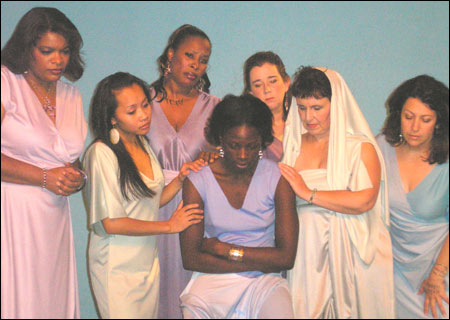It’s from the perspective of a man, but The Well of Woman makes a brave attempt at honoring and, to some extent, understanding what women go through, especially if they are African-American. Written and directed by Ricardo Pitts-Wiley, the 85 minutes of song and commentary are at Mixed Magic Theatre through November 19.

COMPASSION: The troup lends support to Michaelle Santil.
|
Seven women, of assorted colors and sizes, present the songs and bridging observations. The music is by Pitts-Wiley and Robert Schleeter, with music director Paul Bisch on keyboards. The voices range from quite good through respectable to frequently off-key.
The program lists more than a dozen songs and nearly twice that many spoken passages and poems. Starting us out with the title song, Kelly House is in good voice. She and Elisa Heath are the vocal standouts here, and not only when they get together in a punchy duet titled “Where Do Running Girls Run?”
Now and then we hear fragments of stories, such as when Mary Paolino becomes a middle-aged woman who makes sure the kitchen is clean, then takes off her wedding ring, climbs into a taxi, and escapes her dull domestic life. Michaelle Santil reminisces about a high school boyfriend, a nerd who won the science contest when she won the dance contest. Men also come into the picture when the biological imperatives of “The Prime Directive” are listed on a couple of occasions. (“Let off some steam,” “maintain the species,” “bond.”)
ADVERTISEMENT
 |
Basic social and existential questions come up, such as when Charlie Ek asks and sings “Who Made the Rules?” Ayana Nickerson and Jeannine Carson discuss “When Girlfriends Become Women Friends.” Humor crops up once in a while, including when the ensemble gives examples of being untruthful to be kind, in a piece titled “I Guess I Lied About That.”
With composer Schleeter, his longtime collaborator, Pitts-Wiley has written numerous shows that weave together songs and observations. The first was Celebrations: An African Odyssey in 1979, which has had more than two dozen productions over the years. That was structured with the template he has used ever since: developing a theme rather than a narrative storyline. On one occasion the focus was exclusively male, when A Secret Meeting of Black Men (1996) examined black identity in the context of the 1995 Million Man March.
In 1984, Pitts-Wiley’s The Spirit Warrior’s Dream looked at how important music is in our lives and what happens when we no longer have that source of comfort. Eight years later he looked into that from a female point of view in Sara’s Jukebox, which was about a depressed woman rescued by spirits of music. As the title of the 1997 cabaret Man, Woman, Chaos suggested, examining relationships between the sexes is a creative activity close to Pitts-Wiley’s heart.
It’s a courageous but risky exercise of empathy to pick over well-mined territory already examined by such authorities as Ntozake Shange, with her poetical 1975 work for colored girls who have considered suicide when the rainbow is enuf. In the program notes, Pitts-Wiley shows his admiration by remarking that “women deal with the truth better than men.”
The problem with The Well of Woman isn’t about truthfulness but rather about words, about making them clear and having them strike the right tone at the right moment. A little more narrative clarity — straightforward storytelling — would go a long way in this fragmented collection of observations.
There is one sequence in particular where a storyline begins to emerge and provide some continuity. What the women called “the fear thing” doesn’t remain abstract but rather gets some disturbing solidity: in a building full of mutually supportive women, one of them is raped, so a cloud of terror descends. Before that point, the collective character of the women is buoyantly established in a passage titled “The Fixer,” where Nickerson and Mary Paolino take pride in being problem-solvers. “My husband has a lot of broken parts,” but that’s not so bad “because I’m a fixer: I fix things — that’s what I do.”
With that, for a moment we are looking at specific women with specific traits. But after the mention of the sexual assault, we recede back into generalities, mostly. Occasionally the musings are refreshingly connected with an image, such as reaching up into a closet and spilling a box of photos onto the floor. With eough of these moments, such accompanying poetical passages as “without the council and comfort of the moon, night would be unbearable” could be satisfyingly grounded.